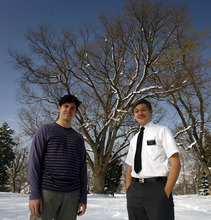This is an archived article that was published on sltrib.com in 2013, and information in the article may be outdated. It is provided only for personal research purposes and may not be reprinted.
"I'm not sure it's fair we have to come of age so young. Sometimes I think if I could do it again, I would get it right this time," says Adam, one of the two friends in Matthew Greene's "Adam & Steve and the Empty Sea." Plan-B Theatre Company is currently giving the play its world premiere in an energized, insightful production that works more times than it misses.
Adolescence is an angst-filled time for most of us: we seesaw up and down trying to define who we are and how we relate to our world and the people in it. Greene's play traces the trajectory of that tumultuous time period through the friendship of Adam and Steve, two young men who start out sharing their sameness only to discover how different they really are. Adam identifies more with his LDS religion and Steve acknowledges he is gay and copes with the challenges that result. The polarizing debate over California's Proposition 8 fractures lines into their relationship.
Greene sets the play during the years when Adam and Steve transition from high school to college at the tree where they played hide-and-seek as children. Scenes also flash back to that happier time, indicated by subtle changes in Phil Lowe's lived-in-looking costumes. Randy Rasmussen's towering wooden-slat tree dwarfs the boys at the same time that it shelters and protects them. The tree—bathed in Jesse Portillo's subtly shifting multicolored lighting—becomes a metaphor for the sustaining strength of memory and shared experience. Their childhood game is echoed in the "games" they play as they grow older, hiding and then divulging secrets about their attitudes and lives.
Greene has an accurate ear for the way young men talk to each other, and the characters of Adam and Steve are sharply drawn and distinguished.
But the play falters at times from a lack of focus, as Adam and Steve's patterns of behavior begin to spread out and repeat themselves. The flashbacks to childhood become more interesting when only one character goes there and the other remains in the present, visually intensifying the growing gap between them.
Topher Rasmussen and Logan Tarantino's dynamic performances minimize the occasional lapses in the writing and are consistently inventive and interesting. Each actor is totally tuned in to his character: Rasmussen's Adam is the perennial peacemaker to Tarantino's more volatile, emotional Steve. Ironically, in spite of the more black-and-white viewpoints of Adam's religious beliefs, it is Steve's attitudes that come across as more inflexible and unforgiving. Director Jason Bowcutt deftly orchestrates the pace so the momentum never lags.
"Adam & Steve and the Empty Sea" poignantly captures the divisions that result from conflicting principles and lifestyles, but it also affirms, in Greene's words, "that faith is a basic human instinct, that love is a healing balm, and that it is often through each other that we glimpse divinity." —
Review: "Adam and Steve and the Empty Sea"
Vibrant and focused performances and taut direction compensate for the occasional lack of focus in this new production by Plan-B Theatre Company.
When • Reviewed on Thursday, Jan. 31; continues through Feb. 10; Thursday-Friday, 8 p.m.; Saturday, 4 and 8 p.m.; Sunday, 2 p.m.
Where • Rose Wagner Performing Arts Center's Studio Theatre, 138 W. 300 South, Salt Lake City
Tickets • $10-$20; at 801-355-ARTS or planbtheatre.org
Running time • 90 minutes, no intermission



